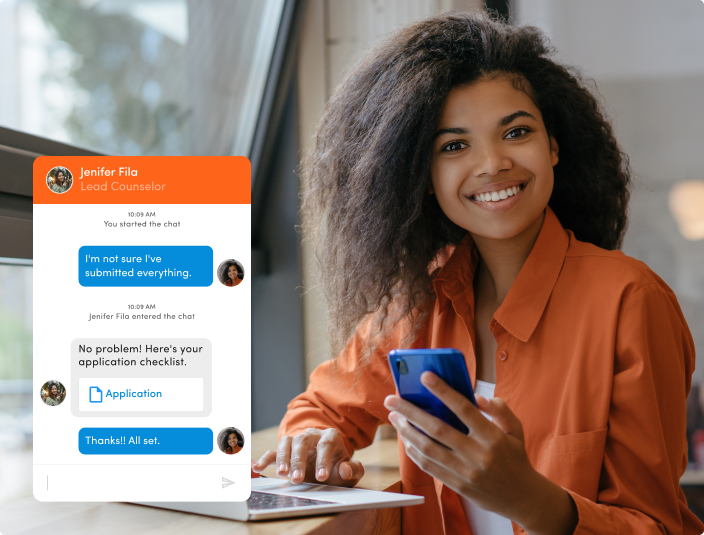4 Steps to Enrolling Direct Admissions Recipients
by Sirley Carballo · Updated Feb 13, 2023
Admitted students are essential to any college, university or higher education institution since they’ve already taken the first step toward enrollment. But what happens when students are no longer applying but are instead receiving direct admission offers?
And what steps are critical to moving a student from admitted to enrolled when offered direct admission?
Regardless of how students are getting admitted, conversion requires genuine engagement that stands out from what other schools are doing. After all, students receiving direct admissions offers may hear from more than one school.
To ensure a successful conversion rate from direct admission to enrollment, higher education institutions need to create a tailored strategy that connects with these special prospective students and their parents.

By implementing a personalized communication strategy, creating a dedicated information hub for each student, providing incentives, and getting parents involved in the process, institutions can provide direct admissions students with a comprehensive view of their school that speaks to their needs and goals and provides the information they need to enroll.
1. Implement a Personalized Communication Strategy
We know that personalization is the key to building genuine engagement. Implementing personalized communication strategies based on different segments of direct admissions learners is an effective way to foster meaningful engagement.
This engagement is what builds brand interest and affinity for your school. Students will engage with schools that show how much they care and know about their prospects.
Begin by exploring all the different ways you can communicate with students:
- Direct mail
- SMS
- Personalized videos
- Live chat
- Phone calls
- Social media
Brainstorm ways to create a personalized communication plan that serves the information students need while streamlining the conversion process. As you learn more about the student, inject their likes, interests, and goals into the communication plan with dynamic content that can easily personalize each message to its intended recipient.
By automating your direct admissions communication campaign, you can let the student’s actions trigger the following message. This way, you ensure they receive the right message at the right time and in their preferred format.
For example, suppose the student has visited the financial aid section of the website twice in one week. In that case, you can set a trigger to email that student about applying for scholarships with a follow-up text message later in the week.
As your campaign grows, use behavioral marketing to measure each student’s engagement and direct them to more relevant content through the college admissions process. This can help you understand what resonates with each student so the content you share is always tailored. Colleges and universities that do this will stay top of mind for students that feel heard and understood.
2. Create a Dedicated Information Hub for Each Student
Provide direct admissions recipients with a unique, personalized hub to explore everything your school offers. At the same time, you’ll learn more about what the student wants.
Customizable landing pages or microsites are a great way to house all the information a student needs while allowing them to share more about themselves. These pages should feel uniquely theirs and prepopulate with dynamic content such as their name, location, and other personal information you’ve already acquired.
Include surveys, embedded social media feeds, maps, and dynamic fields that pull in the info you already know about the student, like intended major or co-curricular and career goals. Make sure to include checklists that automatically update so students can visualize their progress.
Utilize tools such as an embeddable chat box and direct links to forms, so students can search for the information themselves. Remember to include resources such as virtual tours and direct contact with faculty and staff.
3. Create Incentives for Direct Admissions Recipients
Proponents suggest that a direct admissions program can generate more accessibility for students that may not have even thought about applying to colleges and universities. For this reason, it’s essential to recognize how much additional support some of these students may need.
By automating the rest of the processes, colleges and universities can free up more time for staff to connect with students one-on-one and offer personalized support that makes a difference.
Offering exclusive assistance with the enrollment process or early access to events and opportunities can help prospects learn more about your school. Ensure you’re consistently following up with direct admission students, so they understand the process and stay on track toward enrollment.
In addition to enrollment guidance, consider offering scholarships, discounts, or other incentives tailored specifically for direct admissions recipients to encourage enrollment.

See Element451 in Action
Students explore and pick where they’ll earn a degree in completely new ways. Welcome to the new world of enrollment, powered by Element451. Are you ready to take your efforts to the next level?
Schedule a Call
4. Get Parents Involved in the Decision Making Process
Parents play an important role in decision-making, so it’s important to involve them in your communication strategy. According to Encoura, three-quarters of parents appreciate a college targeting them but only about half of all parents receive any higher education communication addressed to them. This means parents are an untapped resource in the college decision-making process.
It’s important that your communication to parents isn’t just a direct copy of what you’re sending students. Try to put yourself in their shoes and communicate what truly matters to them. Parents are most often concerned with topics such as:
- Cost of attendance + scholarship offerings
- Academics and intended major
- Internship and career opportunities
- Health and safety on colleges and university campuses
Just like prospective students, you can also build an automated communication plan for parents that keeps them in the loop and helps them build their own affinity toward your school. Parents are critically influential in the college decision-making process. Engage parents as much as possible to help them as they guide their child to make an informed higher education decision.
An Engagement Strategy That Converts Direct Admissions Recipients
Creating a successful enrollment strategy for admitted students is essential in order to maximize the number of students that move from admitted to enrolled. To do this, colleges and universities should create a personalized communication strategy, offer campus tours, provide incentives, and include parents in the higher education experience.
Through automation, personalization and meaningful engagement, colleges and universities can ensure that direct admissions students understand the benefits of their school while also providing them with the necessary information to make an informed decision. To learn how your school can utilize Element451 to save time and focus on converting students, schedule a quick call to see it in action.

About Element451
Boost enrollment, improve engagement, and support students with an AI workforce built for higher ed. Element451 makes personalization scalable and success repeatable.
Categories
New Blog Posts

The Definitive Guide
AI in Higher Education
Bridge the gap between the latest tech advancements and your institution's success.
Useful Links
Related Articles

Talk With Us
Element451 is the only AI Workforce Platform for higher education. Our friendly experts are here to help you explore how Element451 can improve outcomes for your school.
Get a Demo








